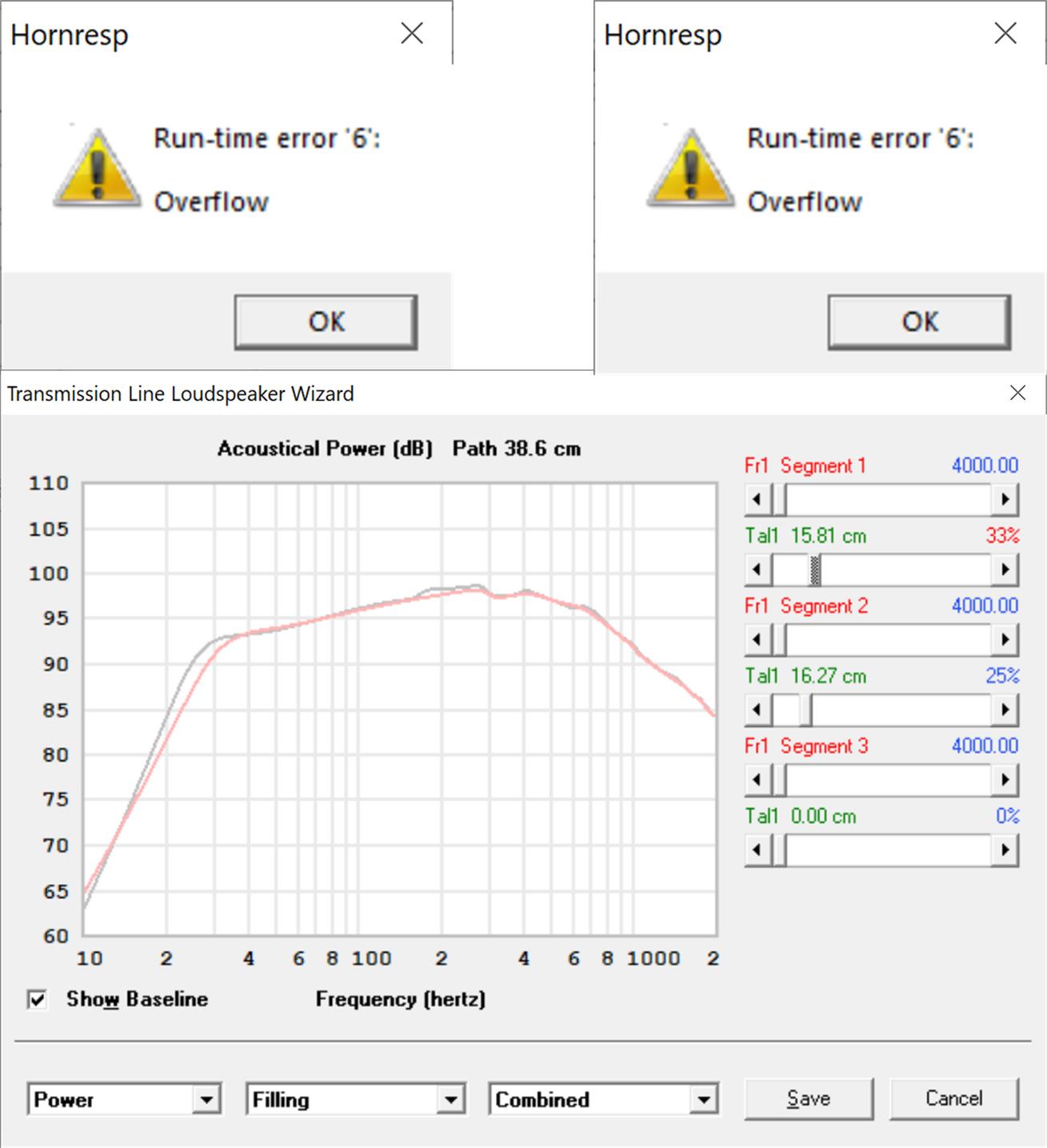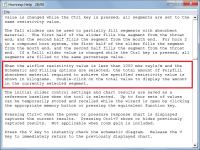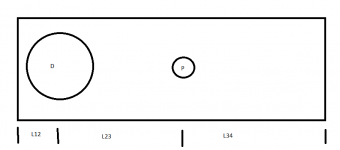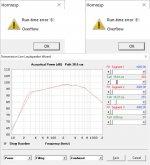Any chance this could be modified to specify the mass kg/m^3 and a mks rayls/m number.
Unfortunately there is no simple relationship between resistivity and density - it depends upon the structure of the absorbent material.
The Fr1 absorbent filling material slider values are shown in units of mks rayls/m, and the amount of Polyfill material having the same resistivity, is shown in kilograms.
Attachments
Unfortunately there is no simple relationship between resistivity and density - it depends upon the structure of the absorbent material.
The Fr1 absorbent filling material slider values are shown in units of mks rayls/m, and the amount of Polyfill material having the same resistivity, is shown in kilograms.
As you have probably guessed I'm hoping to model a few mineral wool products on the back of the driver. I do have the relevant information as I mentioned. I'll look up airflow through a fibrous tangle again.
Oh the possibilities 😉I've been having fun with HR all week designing twin BP4's for 2 Parts Express' GRS 12SW4's. I've modeled Nd, Nd with closed front, OD, and BP4 functions. HR is addictive! I'm thinking of painting them orange like NFL scoring pylons. I got a new 3 piece sectional for the man cave and I want some end table subs.
Brown is old. Smoke is new.
I've been having fun with HR all week designing twin BP4's for 2 Parts Express' GRS 12SW4's. I've modeled Nd, Nd with closed front, OD, and BP4 functions. HR is addictive! I'm thinking of painting them orange like NFL scoring pylons. I got a new 3 piece sectional for the man cave and I want some end table subs.
Brown is old. Smoke is new.
Smokin'.
I'd get a beer tap setup for that cave.
I don't have that myself, I have to cross another room to get to my beer kegs...
Overflow when F9 to export in the wizard
Hi David:
I ran into overflow error that crashed HR exporting SPL from the wizard when running attached GM,s TL model from Camplo's thread. The model as posted doesn't lead to overflow but changing the Fr and Tals and then exporting sometimes does. What caused the bug for me was setting Fr of segment 2 to 4000 and its Tal to 25%. It was repeatable until I wrote this bug report. I think there is something lurking there.
Jack
Hi David:
I ran into overflow error that crashed HR exporting SPL from the wizard when running attached GM,s TL model from Camplo's thread. The model as posted doesn't lead to overflow but changing the Fr and Tals and then exporting sometimes does. What caused the bug for me was setting Fr of segment 2 to 4000 and its Tal to 25%. It was repeatable until I wrote this bug report. I think there is something lurking there.
Jack
Attachments
Hi Jack,
Thanks for the very clear and detailed feedback. Unfortunately I have not been able to generate the error myself, so at this stage I don't know where to go looking for the problem. I gather from your comments that you had some difficulties also, in repeating the error consistently?
Kind regards,
David
Thanks for the very clear and detailed feedback. Unfortunately I have not been able to generate the error myself, so at this stage I don't know where to go looking for the problem. I gather from your comments that you had some difficulties also, in repeating the error consistently?
Kind regards,
David
Last edited:
I've been having fun with HR all week designing twin BP4's for 2 Parts Express' GRS 12SW4's.
Nice 'bed'! 😉
After looking at the specs it didn't seem to be usable, but plugged the numbers in for a classic 'max flat' BP4 to 'road test' the Wizard and of course was severely under damped, but using hi/lo filters it turned out good enough that stuffing to 'taste' should finish it off. The downside is it only sims ~93 dB/6.2 mm Xmax at its 240 W max power if I did it right, so not loud, just small [to me] @ ~80 L, but for the price, guess it's OK.
GM
Attachments
I need some help here. I want to simulate best port placement in a high narrow bass reflex speaker. But I cannot figure out how to do it, or if it is possible (it should 🙂 ). I have tried all variants of stubbed enclosures.
I made a picture of the design. D=driver. P=port
I made a picture of the design. D=driver. P=port
Attachments
Spooky. I can't do it again either, even going back to the original import and starting over. But Murphy was on the job. It did it repeatedly right up until the moment I wrote the bug report.Hi Jack,
Thanks for the very clear and detailed feedback. Unfortunately I have not been able to generate the error myself, so at this stage I don't know where to go looking for the problem. I gather from your comments that you had some difficulties also, in repeating the error consistently?
Kind regards,
David
Perhaps I lulled Murphy into a false sense of security by admitting defeat, but give up isn't in my vocabulary.

I got to this point originally by changing the Frs to 4000 which I use for fiberglass fill, then attempting to get back to GM's response with polyfill.
I got to this point originally by changing the Frs to 4000 which I use for fiberglass fill, then attempting to get back to GM's response with polyfill.
Attachments
Smokin'.
I'd get a beer tap setup for that cave.
I don't have that myself, I have to cross another room to get to my beer kegs...
That would be nice, but I don't drink.
Nice 'bed'! 😉
After looking at the specs it didn't seem to be usable, but plugged the numbers in for a classic 'max flat' BP4 to 'road test' the Wizard and of course was severely under damped, but using hi/lo filters it turned out good enough that stuffing to 'taste' should finish it off. The downside is it only sims ~93 dB/6.2 mm Xmax at its 240 W max power if I did it right, so not loud, just small [to me] @ ~80 L, but for the price, guess it's OK.
GM
Where did you get Sd = 506cm2? I've been using the cut out diameter (11.125in2 x 2.54cm2 x 0.7854) for Sd. Parts Express doesn't list Sd for the GRS 12SW4.
Actually, I have not been modeling flat response BP4 enclosures. Guys on on avsforum.com have designed a BP6 enclosure called the Devastator that ramps up to 100hz with an 18hz tune for an 18" (PA460) or 21" (LaVoce) sub. They modified the enclosure for 4 $29 JBL CS1214 or CX1200's that perform better than the 21" sub version. The $29 JBL 12 is another thread on the site. Anyways, I've been modeling the dual GRS 12SW4 BP4 with around a 60hz tune which ramps up to 80+hz. I think 1 enclosure is 38.25"H x 20"W x 22.25"D externally. The internal cross section of both chambers are 18.5" x 10". Front chamber is 26" long. The rear chamber is L shaped since the 26.75" chamber and 21.5" port (from the front exit to the back wall of the enclosure) are combined. I'm on my phone and have models on 2 different laptops to the exact information.
I need some help here. I want to simulate best port placement in a high narrow bass reflex speaker. But I cannot figure out how to do it, or if it is possible (it should 🙂 ). I have tried all variants of stubbed enclosures.
I made a picture of the design. D=driver. P=port
You can figure it out using the 'path' slider in 'chamber', but both the driver and vent should be at a vented pipe's odd harmonics: internal height [L] x ~ 0.217, 0.349, 0.424, 0.66, 0.714, 0.848 or on top and bottom. The vent opening causes a downward shift, hence the distances being further down that a closed box's 1/5, 1/3rd, etc..
GM
Where did you get Sd = 506cm2?
Actually, I have not been modeling flat response BP4 enclosures.
Well, I could have calculated it, but happen to know that the vast majority of 12" drivers ever made has ~78-78.5"^2/~503.23-506.45 cm^2 diaphragms and ~506 cm^2 is the most common nowadays, so 'took a shot' and it was close enough since it didn't alter Vas much and Fs, Qe, Qm at all, though I could have/just did fine tuned it by changing it in increments till it hit the Vas spec to a couple of decimal places, which at 514.02 cm^2 is well above the norm, so guess it could be due to the high Xmax, but more likely the Vas spec is wrong.
Regardless, in the scheme of things re box design, using the cutout area just sims a little bit bigger box alignment, so your call as to whether you want to use HR to tediously align with the Vas spec [the one most often wrong] or a most common Sd spec.
Anyway, IIRC GRS is noted for [very] inaccurate specs, so both our sims may require significant DSP to perform well.
As you should, I only recommend T/S max flat alignments for outdoor apps, just I have a quick/easy design routine to create a basic compression driver [BP4] to see what's what with this seemingly totally incompatible set of specs and wasn't meant as a suggestion for your app.
GM
Perhaps I lulled Murphy into a false sense of security by admitting defeat, but give up isn't in my vocabulary.
Hi Jack,
Murphy can be very frustrating sometimes - many thanks for persisting 🙂. I have now been able to generate the error myself, which has allowed me to quickly identify the problem - and which is due to an oversight on my part.
The absorbent filling material model used in Hornresp is a very good one, but breaks down mathematically at high frequencies due to numerical overflows and underflows. There is nothing that can be done about this, and it is why the wizard charts are limited to a maximum frequency of 2000 Hz when absorbent filling material is specified. The exported data however extends to 20000 Hz, which is why the overflow error is occurring. The solution will be to limit the exported data frequency range to 2000 Hz when absorbent material has been specified. I should have done this originally, but completely overlooked the need for it. It will be fixed in the next update.
Further information on the nature of the problem is given in Post #3924: https://www.diyaudio.com/forums/subwoofers/119854-hornresp-393.html#post3747637
Thanks again for reporting this bug. I doubt that I would have found it myself 🙂.
Kind regards,
David
I want to simulate best port placement in a high narrow bass reflex speaker.
Hi Mårten,
The offset driver / port configuration shown in your diagram cannot be simulated using Hornresp.
Kind regards,
David
Hmm, FWIW, using the 'path' slider in 'chamber' to move it yields from admittedly dim memory, ~ identical results to MJK's with the only obvious difference being HR's strong 'spiking' that his show somewhat damped even with no stuffing.
GM
GM
Hi Mårten,
The offset driver / port configuration shown in your diagram cannot be simulated using Hornresp.
Kind regards,
David
Thanks David. Put it on my wishlist.
I need some help here. I want to simulate best port placement in a high narrow bass reflex speaker. But I cannot figure out how to do it, or if it is possible (it should 🙂 ). I have tried all variants of stubbed enclosures.
I made a picture of the design. D=driver. P=port
Give me some support here. Maybe we can persuade David to implement this if we stick together 😀
- Home
- Loudspeakers
- Subwoofers
- Hornresp



